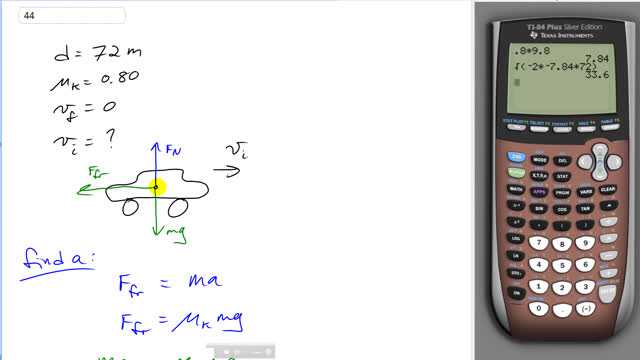
Police investigators, examining the scene of an accident involving two cars, measure 72-m-long skid marks of one of the cars, which nearly came to a stop before colliding. The coefficient of kinetic friction between rubber and the pavement is about 0.80. Estimate the initial speed of that car assuming a level road.

In order to watch this solution you need to have a subscription.
This is Giancoli Answers with Mr. Dychko. As the car is skidding to a stop with a velocity initially to the right, there must be a friction force directed at a left to make it decelerate, and there's also normal force up and gravity downwards. And so, we'll find the acceleration knowing the friction force is the net force because there's no other forces horizontally, and so, it's mass times acceleration. And then we have another expression for a friction force that it's coefficient of kinetic friction times the normal force which is mg in this case. And so, we have ma equal to muK mg, and we'll solve for a by dividing both sides by m. And we get acceleration is 0.8 times 9.8 meters per second squared which is 7.84 meters per second squared. And then knowing that acceleration we'll figure out the initial velocity must have had, knowing that it comes to a stop here. So, Vf is zero. And we'll subtract 2ad from both sides and then switch the sides around. And we get Vi squared is negative 2ad. And so, Vi is the square root of 2 times acceleration times displacement. So, it's square root of 2 times 7.84 meters per second squared, and we'll make that acceleration negative because we know it's opposite in direction to the initial positive velocity. And the displacement is in the same direction as the initial velocity to the right, 72 meters, so, it's positive. Then we end up, you know, not having our calculator blow up trying to take a negative square root. And we get 34 meters per second must have been the initial velocity. If you multiply that by 3.6, you can see how many kilometers an hour that is and, which is quite fast, 120.